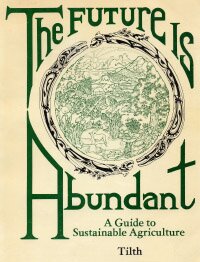
The Future is Abundant
A Guide to Sustainable Agriculture
Tilth Producers of Washington Home | WA Tilth Assoc. | Conference | Directory | Journal | Placement Service | Calendar | Action Alerts
Legislative Update | Bulletin Board | Classifieds | Questions on Agriculture? | Photo Gallery | Links | Contact Us | Join Now | Volunteer

Maryanne Carruthers-Akin, a Portland artist, has developed a highly productive gardening system in which earthworms do the digging. The mulched beds have also eliminated the problems of frequent weeding and struggling with resistant soil. Maryanne believes her method is ideal for the city gardener who wants to transform his or her backyard into a food factory.
Garden beds (shown above) are four feet wide, in a shape or length that fits the site. After outlining the area with stakes or string, she evenly applies to every 40 square feet one pound or more of dry molasses to attract the earthworms, and one-half pound or less of kelp powder to provide nutrients to the soil. She then spreads newspapers, about five sheets thick, over the surface, using a thicker layer if the lawn is poor and plagued by weeds.
After wetting down the newspaper to keep it in place, Maryanne covers the bed evenly with damp straw, which tends to be less expensive and contain fewer weed seeds than hay. For the initial bed, one bale of straw adequately covers 40 square feet. After that, she replenishes the straw as needed.
Instead of planting seeds directly into the beds, Maryanne uses Todd Speedling trys, in which each seedling develops an individual, pyramid-shaped root ball. To set the transplants in the garden, she pulls back the straw, exposing the soil. Then she adds two to four cups of compost, one-quarter cup of bone meal and a pinch of dried alfalfa leaves to the exposed soil. She sets plants in deep, because until the earthworms become actively involved in the tilling, the plants are, in effect, growing in straw flower pots, and can easily dry out.
To encourage growth, Maryanne uses a garden tea made of one tablespoon fish emulsion, a tiny dribble of seaweed emulsion, and one tablespoon of liquid molasses, which she mixes in one gallon of water. Vegetables are fed with this mixture every two weeks during the growing season.
Maryanne finds that once this system is set up, the rest is easy. She has found that, with the exception of turning the compost tumbler and processing kitchen scraps, she and her two housemates work only one afternoon a week from mid-February to mid-November to maintain the garden. Maryanne is pleased that the garden produces food for her household all year round, and as an artist, she also appreciates the fact that the design of the garden holds up all year.
Tilth Producers of Washington Home | WA Tilth Assoc. | Conference | Directory | Journal | Placement Service | Calendar | Action Alerts
Legislative Update | Bulletin Board | Classifieds | Questions on Agriculture? | Photo Gallery | Links | Contact Us | Join Now | Volunteer